Day 3
Monday, 11 November
Mangatepopo to Whakapapa (9 km)
With the convenience of a DOC campsite come certain disadvantages. Here, a tramper in a neighbouring tent snored the night away. Now, my husband snores voluptuously, but I’m accustomed to his nocturnal tones and timbre. It took me ten searing years to acclimatise but I got there in the end. However, any new kind of snore derails my sleep. This fellow tramper sounded like a calf with an ever-tightening noose around its muzzle, while seriously trying to communicate matters of bovine emergency. Snoooo-hrrrrm – Gnnaaaaar-hup – Flrrrrrr-bah – Gaaaaang-Grrrroooof. The syllabic variety would have been fascinating if it hadn’t incited resentful bloodlust in my semi-vegetarian, PETA-oriented, Geneva Conentionesque and Green Peacicle buzooms.
When I staggered, utterly destroyed, out of the tent at dawn, the guilty party was doing healthy stretching exercises in the golden light. He had a great big fuzzy beard like a garden gnome and a serene smile. His ambience came with having had a refreshing night’s sleep and he greeted us with a tourist’s happy affability. There are times when a tent peg shouldn’t be driven into the earth. No, a more appropriate location awaits it.
There is always a DOC warden at the Mangatepopo Hut. It was the last morning of Sylvie’s five-day stint when we were there and she had to carry out a large cardboard box of junk. Despite the strict rules about leaving nothing but footprints, some trampers still think other people are honoured to pick up after them. I asked her how often DOC had to rescue trampers who found they could not complete the walk. DOC hadn’t, during her time, but she said many walkers were seriously underprepared when they did the crossing. “The weather can change in minutes, but they don’t even take a long-sleeved top or waterproof jacket.” “We saw!” I replied. “Yesterday we encountered people walking without water, or in skimpy shorts and vests. They must have got badly burned.” There were also many morbidly obese folk and one woman who looked like she was seriously dropsical. Mind you, we passed her a few kilometres from the end, and she looked like she was going to make it to the car park with the help of her partner, despite her being in rather a bad way. And an elderly bloke overtook us during our final descent; he was wearing canvas slip-ons, the type we used to call sandshoes. He must have been pretty footsore that night.
We had an easy walk from Mangatepopo to Whakapapa, the base camp for skiers. The 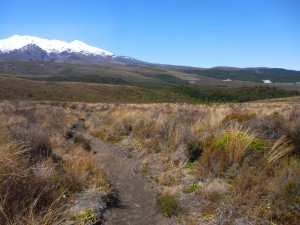 path was badly eroded in places, but it was only a nine kilometre distance and mainly flat. After climbing Red Crater, this section was a doddle. There was an amazing alpine groundcover near Mangatepopo. White, low-growing and extremely dense, it looked like snow. The vegetation increased in height with distance from the volcanoes, but fauna remained largely unseen. We encountered a moth, a bumble bee, and a lark. That was it.
path was badly eroded in places, but it was only a nine kilometre distance and mainly flat. After climbing Red Crater, this section was a doddle. There was an amazing alpine groundcover near Mangatepopo. White, low-growing and extremely dense, it looked like snow. The vegetation increased in height with distance from the volcanoes, but fauna remained largely unseen. We encountered a moth, a bumble bee, and a lark. That was it.
After only two nights on freeze-dried food, our bodies were whimpering for something fresh, so we stopped at the Whakapapa village restaurant for lunch. We could have gone on eating all afternoon, but with an eye rolling towards the budget we had to stop at one dish each. The restaurant was decorated with photos of the various eruptions of the surrounding volcanoes, all with the comparatively weeny Whakapapa buildings crouched in the foreground. Isn’t this a bit like going on a ferry day trip with grisly pictures of shark attacks on the cabin walls?
We set up Samson at the holiday camp and frisked over to the ablution block for the indulgence of washing. Oh joy! There was a bath! We went to bed in the mid-afternoon, but I was woken up in the early evening by a hell of a racket. It sounded like a rubbish truck’s pneumatic whining, metallic clanking and general rattling, but it went on, and on, and on. I crawled out to have a look. Yes, it was a rubbish truck. The driver was morose. He had come to collect the camp skip, had raised and tipped it, but alas had not first opened the truck’s hatch, so the noisy smelly stuff had showered everywhere. There is always some poor soul, somewhere, having the perfect end to a bad day.
Day 4
Tuesday, 12 November
Whakapapa to Mangahuia campsite (12 km)
The scenery on this section was so good I was clicking all day like a Geiger counter. We took too many photos to put in a blog entry, so visit “Gallery” if you want to see more.
The track started in forest, through which Golden Rapids flowed. At first glance, the water looks brown, but then you realise it is brilliantly clear; it is the stones and bed that are rusty. This is due to a clay coating, containing aluminium from andesite rock and colour from the action of iron oxides.
The trees are different from those in other North Island bush areas. Lichen makes sharp white and black patches beside the moss on the trunks, and the taller trees hold 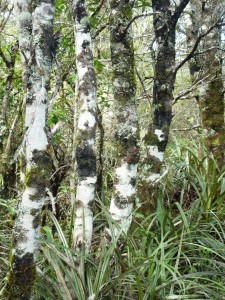 their branches closer to their chests. In some places, the trees look like oddly magnified bonsais, twisted and old, but only about two or three metres tall.
their branches closer to their chests. In some places, the trees look like oddly magnified bonsais, twisted and old, but only about two or three metres tall.
We emerged from the trees into bog areas with low alpine vegetation where the path became a boardwalk to protect the plants. These bogs are a result of old volcanic activity in that the underlying ash deposits stop water draining away. The mud is different here too; it is not like the clinging silt of mangroves or the earthy malleability of pastures. It is peat, comprising tiny shreds of blackened alpine vegetation. Unlike silt and clay, it can be removed from your boots with a single whack.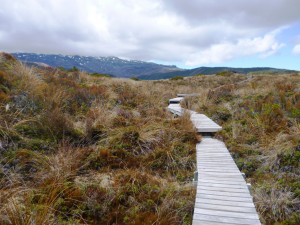
Largely following a contour, we walked across the scars of several landslides, where the slopes were stripped and stony, before re-entering the forest. The moss colours ranged from maroon to pale mint and there were some amazing barks, my favourite being the copper and silver striped ones.
When we took the fork to the Mangahuia campsite, the path deteriorated substantially. From here on it was very squelchy and slow walking and we both fell a few times. On the first occasion I hugged the planet, I had difficulty getting up. Hannah rushed to me in a gratifying show of concern, but instead of gripping my arm, she scrabbled at my pants. The truth dawned…she wasn’t trying to help. She was trying to get our camera out of my pocket to photograph me wedged between two tussocks, with my legs weakly waving. So I bit her. When you walk in the bush, it is beautiful when Love is your partner and you continually act on the question “What would Jesus do?”
A few kilometres from the end of the day’s section, we crossed yet another stream in thick forest. “Let’s have a skinny dip,” I suggested to Hannah, fully expecting the answer No. “I will if you will,” said Hannah. “Right,” I responded, undoing only my top button. She did likewise. “You’re not allowed to look, though,” she insisted, “Promise?” “OK.” So we stripped. I turned, to check that she really was getting into the water behind me. “Don’t be a Peeping Mom!” shrieked my child (she with the vulgar mind), clutching herself modestly. “Very good, Hannah,” I said. “I’ll put that remark in the blog.”
There was still snow on the mountain and the water was burningly cold, so we did a lot of squealing. “Ooo, you’ve got a weird rash on your bum,” said Hannah. So much for her right not to be seen starkers by her Mom being balanced by an unspoken corresponding duty not to look at her starkers Mom. Pfffft!
Leaving the water, we realised we had started our swim on the wrong side of the stream. There was no bridge and the water was thigh deep, so we had to take our gear to the other side before drying and getting dressed. I did this at once, but Hannah was a bit slow and awkward. Eventually, wearing only her bra, and carrying her pack on her back, she started to cross. She made an unusual sight. “You still mustn’t look, but it is slippery here, and if I am about to fall you’ll have to jump in and help me,” she ordered. “But how can I know if you’re falling if I’m not allowed to look?” I asked in bewilderment. A cry, she explained, with exaggerated patience, would alert me to her difficulty. “Ja, but I’m too deaf to hear you quickly enough,” I said, taking a tooth for a tooth about her pointing out my rash.
When we zipped our tent closed to sleep at 6.30 that evening, there were only two other tents nearby. During the night, several other folk arrived and quietly pitched. Not so with one group of youth at 9.30 pm who interacted so noisily and at such length that we all woke up and involuntarily learned their names. Flashing their torches around, they walked up and down beside our silent tents. “Geez, check at all these people!” shouted Dylan. Gosh, ya figure? At a public camp site? Jocinda, Meridy and Kayleigh pitched right next to us, and had a high volume, long and boring conversation about socks. Where oh where is that calf muzzle noose when you want it? Or better still, a rubbish avalanche from a skip?
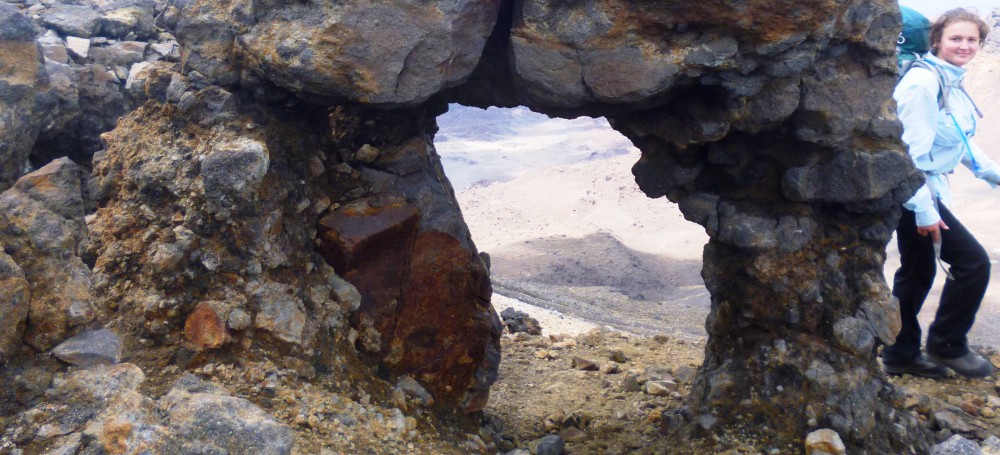
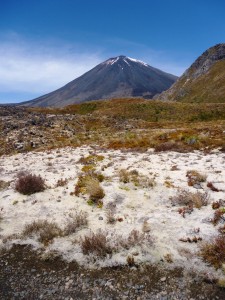
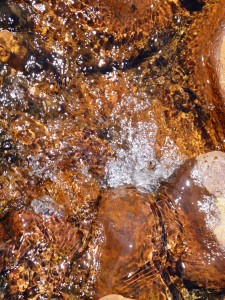
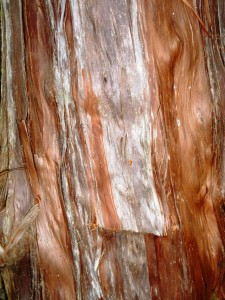
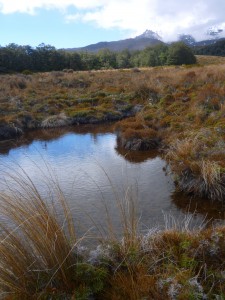
so has your rash gone now?
Yes (blushes modestly)